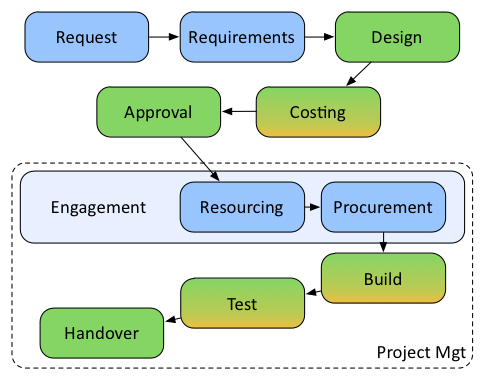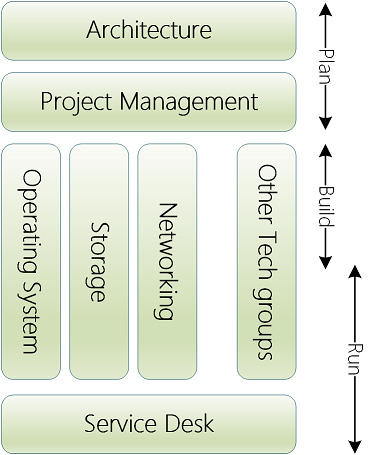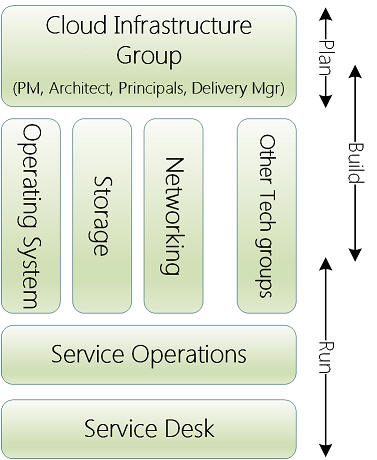This is a rough approximation of most IT Infrastructure organisations I’ve worked in – minus management of course!
As you can see it’s very silo-ed. The only reason it functions at all is because IT people are highly developed socially, able to communicate without using jargon, and can comprehend the bigger business issues without being too precious about technology. Pfffft… Bollocks! The only reason it functions at all is because of large cross-silo teams of project managers, infrastructure architects and service managers that run around like Mel Gibson in Gallipoli trying to get the message around about what needs to be done.
A typical workflow for an IT project might be something like this (The cells with green indicate cat-herding, high-cost activities):

If you’re lucky, some activities may have been automated and orchestrated (shown above as green/orange), which expedites and standardises projects.
This process is implemented in a pretty predictable and fixed way. And for good reason. “Management by Projects” has been a pretty consistent way of running IT even if weekly time-sheets are a menial fiction we all loathe. It’s only the mega-budget, long-term projects that have a special way of going awry.
The organisation in the first diagram won’t scale in the era of cloud computing though. It’s too cumbersome. Everyone loves cloud computing because of the low transaction costs (initial build cost and time-to-market). Instant gratification wins most of the time even if it costs more over the long term.
An organisation structure that can support this instant gratification will be one where the silos have shrunk. I’ve attempted to show this in the updated organisation below:
IT Generalists and specialists with a propensity and willingness to cross-skill are moved into new Cloud Infrastructure and Service Operations teams. Over time these teams grow as your “traditional” silos atrophy.
You’ll still need experts in silos, whether in-house or out, to look after physical assets and organisational-wide compute, storage and network domains but the new cloud groups will be responsible for delivering IT and business projects.
Your silo-ed database specialists will have experience with big database technologies that aren’t that flexible and your storage and networking specialists will be experienced with enterprise-grade technologies that don’t necessarily have a cloud equivalency.
In many cases the perception, quite rightly, will be that cloud equivalents for databases, networking and storage are unsophisticated and lacking in features. The perception is right but changing.
The new organisation should drive efficiency, consolidation and consistency making internal IT environments (internal cloud, hybrid cloud etc.) more competitive with external cloud platforms.
This new world requires upfront investment and a faith that if you build they will come. But they – the business – will also need some encouragement. And the best way of doing this is to:
- Limit their platform options – Stop putting things on legacy platforms. Use your cloud options.
- Let them “play” on the new system – Users can spin up their own sandpit environments with a light-touch approval process (have them auto-expire… the sandpit environments, not the users!)
- Encourage development teams – Talk about the concepts inherent in cloud platform development.
- Develop a cloud business architecture with agreed terminology and artefacts.
It’s not exactly bustin’ them freakin’ silos but it’s a start. Now we only need to deal with the organisational politics to make this all happen….




